Vintage Treasures: The Doom That Came to Sarnath by H.P. Lovecraft
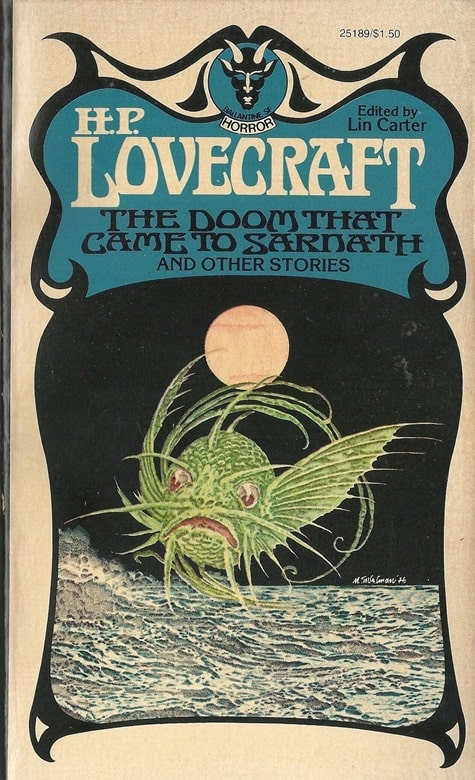 |
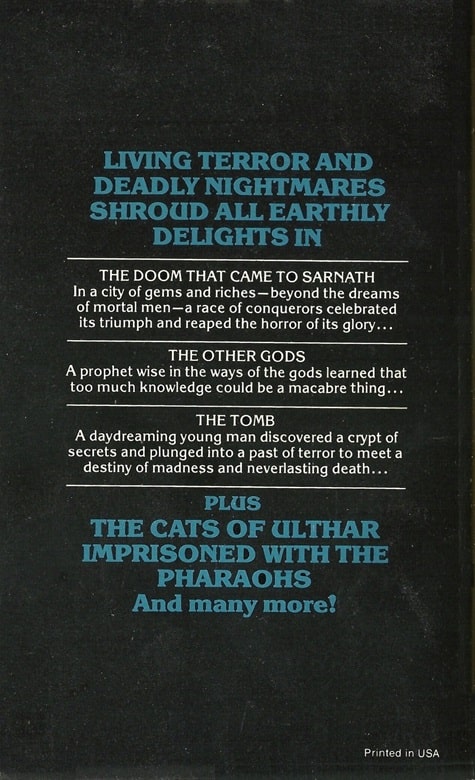 |
The Doom That Came to Sarnath (Ballantine Books, November 1976). Cover by Murray Tinkelman
H.P. Lovecraft, creator of the Cthulhu Mythos, was one of the greatest horror writers of the 20th Century. But horror wasn’t all he produced, as editor Lin Carter adroitly pointed out in the introduction to The Doom That Came to Sarnath.
Those readers who know only the Cthulhu Mythos stories, know only a single side of Lovecraft… the Cthulhu Mythos, while completely his own invention, was constructed along the guidelines established by earlier writers whom he greatly admired… But far beyond his borrowing of basic techniques from Machen and Chambers, Lovecraft is more deeply indebted to the great Anglo-Irish fantasist, Lord Dunsany… not content to make up his own geography, Dunsany invented the religion to which his imaginary worlds paid worship. An extremely clever, even brilliant, idea, and one which has been used by many writers after him. Lovecraft used this theme as the basis for his own Cthulhu Mythos.
As a young reader, Lovecraft was enthralled by Dunsany’s superb fiction. Many of his earliest tales… are Dunsanian in texture and color… Last year I edited a volume of the most Dunsanian of these tales, The Dream-Quest of Unknown Kadath… I would have liked to have included all the fiction from Lovecraft’s “Dunsanian period” in that single book, but the size of the volume would have been impractical. Hence, this second collection.
The Doom That Came to Sarnath contains 14 stories and poems from early in Lovecraft’s career (1919-1925), plus half a dozen later tales, including his famous collaboration with Harry Houdini, “Imprisoned With the Pharaohs.” Although many of the tales — including the title story — are deliciously macabre, there’s very little horror here. It is, as Lin Carter promised, a surprise and delight for those who know Lovecraft only as a horror writer.
[Click the images to dream of bigger versions.]
The Dream-Quest of Unknown Kadath, the first collection of Lovecraft’s
“Dunsanian tales” (Ballantine Books, 1976). Cover by Murray Tinkelman
Lin Carter was under contract to deliver a book every month to Lester del Rey at Ballantine Books, which he did without fail from May 1969 to April 1974, producing an astounding 65 volumes in those 60 months, virtually all for the Ballantine Adult Fantasy Line. Both The Dream-Quest of Unknown Kadath and The Doom that Came to Sarnath were part of that illustrious catalog, released in May 1970 and February 1971, respectively.
After the Ballantine Adult Fantasy imprint folded in mid-1974, Carter continued to edit books for del Rey on a semi-regular basis, including six additional Lovecraft-related volumes — three fiction collections, a critical appraisal of the Cthulhu Mythos, and a pair of August Derleth collections of Cthulhu tales — all with his usual editorial annotations.
In 1976 Lester del Rey released the entire set of eight books in paperback, with covers by Murray Tinkelman, including repackaged editions of the first two collections, plus L. Sprague de Camp’s 1975 Lovecraft biography. They make a handsome addition to any modern fantasy library.
Seven Lovecraftian volumes from Lin Carter/Ballantine Books, all with covers by Murray Tinkelman
The books are:
The Doom That Came to Sarnath, by H.P Lovecraft (1976)
The Lurker at the Threshold, by H.P. Lovecraft and August Derleth (April 1976)
The Mask of Cthulhu, by August Derleth (May 1976)
The Trail of Cthulhu, by August Derleth (June 1976)
The Horror in the Museum, by H.P. Lovecraft (July 1976)
The Case of Charles Dexter Ward, by H.P. Lovecraft (August 1976)
Lovecraft: A Biography, by L. Sprague de Camp (August 1976)
The Dream-Quest of Unknown Kadath, by H.P. Lovecraft (November 1976)
Lovecraft: A Look Behind the Cthulhu Mythos, by Lin Carter (December 1976)
The Doom That Came to Sarnath is an uneven volume, especially if you’re more familiar with the H.P. Lovecraft of “The Call of Cthulhu” and “The Shadow Out of Time.” These are old-school fantasies, heavy on tone and atmosphere. The title story, for example, unfolds over a period of a thousand years and has none of those useless narrative adornments like dialog, or characters.
It’s pure quill story, my children. It has lines like,
It is written on the brick cylinders of Kadatheron that the beings of Ib were in hue as green as the lake and the mists that rise above it; that they had bulging eyes, pouting, flabby lips, and curious ears, and were without voice. It is also written that they descended one night from the moon in a mist; they and the vast still lake and gray stone city Ib.
This whole book reads like something carved on a brick cylinder, actually. Is that a bug or a feature? If you’re asking that question, this probably isn’t the narrative excursion for you.
First edition of The Doom that Came to Sarnath, part of the Ballantine Adult Fantasy
line edited by Lin Carter (Ballantine Books, February 1971). Cover by Gervasio Gallardo
Well, then. What do modern readers make of The Doom That Came to Sarnath?
It has an impressive 4.08 rating at Goodreads — higher than any of the contemporary fantasy collections I’ve read this year, believe it or not. My favorite modern review is from S. Zahler, from 2020.
The titular story and the extremely short tale “The Tree” are good, simple, moody as hell prose paintings — fabular fantasies in the poetic Lord Dunsany style. The collection also has “The Festival,” which is my favorite of HPL’s very short stories — it has such a foggy, dreamlike narrative and progresses through increasingly weirder New England environments and concludes with a stellar closing line.
“The Quest of Iranon” is a beautiful and emotional fantasy short story that is far more sentimental than any other I’ve read by this author. “In the Walls of Eryx” I’d read before, and it is also a singular HPL work — a sci-fi collaboration with Kennth J. Sterling that revolves around a unique alien world concept.
“The Cats of Ulthar” is a nice short fable, inspired by HPL’s surprising affinity for cats (an affinity I share); “From Beyond” percolates with paranoia, and the tale he ghost wrote for escape artist Harry Houdini is a fun adventure that feels a bit more in line with stories found in the Argosy pulp.
This collection contains mostly lesser known/non-Cthulhu mythos HPL fantasy and horror and sci-fi, and it is rich, wholly enjoyable weird fiction.
Sr3yas has the top-rated review at Goodreads; here’s an excerpt.
Most of short stories in this collection comes under “Dream Cycle.” Many from our world have entered to this ultimate dimension with the help of drugs or by pure chance. Witness the misadventures of these misguided travelers in stories like “Hypnos,” “The White Ship,” and “Ex Oblivione.”
Some beings of dreamland have gotten themselves trapped in our world. You can read their woes in “Polaris” and in the excellent poem “Nathicana”:
My damnable, reddening vision
That built a new world for my seeing;
A new world of redness and darkness,
A horrible coma call’d living.
———- Nathicana (1927)Beautiful, isn’t it?
Then there are the dark legends and fables from the land of dreams itself. Experience them in stories like “The Doom That Came to Saranath,” “The Cats of Ulthar” and “The Quest of Iranon.”
There are also some odd ducks in this collection.
● “The Festival”, one of the early and excellent story from “Cthulhu Mythos”.
● “Beyond the Wall of Sleep” and “From Beyond” revolve around cosmic terrors.
● “In the Wall of Eryx” is an unusual Sci-fi involving space exploration!This indeed is a peculiar collection of stories which varies from excellent to average. The “Excellent” makes this worth checking out!
Here’s a look at the inside front cover, with a delightful b&w illo by Murray Tinkelman.
Inside cover of The Doom That Came to Sarnath. Art by Murray Tinkelman
Here’s the complete TOC.
Farewell to the Dreamlands, by Lin Carter
“The Other Gods” (The Fantasy Fan, November 1933)
“The Tree” (The Tryout, October 1921)
“The Doom That Came to Sarnath” (Marvel Tales of Science and Fantasy, March-April 1935)
“The Tomb” (The Vagrant, March 1922)
“Polaris” (The Philosopher, December 1920)
“Beyond the Wall of Sleep” (Pine Cones, October 1919)
Memory (The United Co-operative, June 1919) — poem
What the Moon Brings (1922) — poem
“Nyarlathotep” (1920)
Ex Oblivione (The United Amateur, March 1921) — poem
“The Cats of Ulthar” (Weird Tales, February 1926)
“Hypnos” (Weird Tales, May-June-July 1924)
Nathicana (1927) — poem
“From Beyond” (The Fantasy Fan, June 1934)
“The Festival” (Weird Tales, January 1925)
“The Nameless City” (The Wolverine, No. 11, November 1921)
“The Quest of Iranon” (Weird Tales, March 1939)
“The Crawling Chaos” by Winifred V. Jackson and H. P. Lovecraft (The United Co-operative, April 1921)
“In the Walls of Eryx” by H. P. Lovecraft and Kenneth Sterling (Weird Tales, October 1939)
“Imprisoned with the Pharaohs” by Harry Houdini and H. P. Lovecraft (Weird Tales, May-June-July 1924)
A Partial Chronology of Lovecraft’s Early Work, by Lin Carter
We covered these Ballantine Lovecraft editions in two previous articles.
Vintage Treasures: The Trail of Cthulhu by August Derleth
Collecting Lovecraft, Part I
The Doom That Came to Sarnath was published by Ballantine in 1976. It is 288 pages, priced at $1.50. The cover is by Murray Tinkelman.
See all our recent Vintage Treasures here.
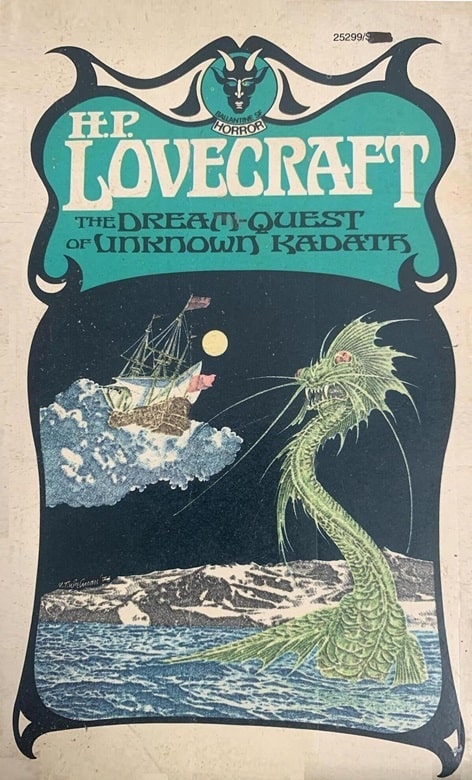
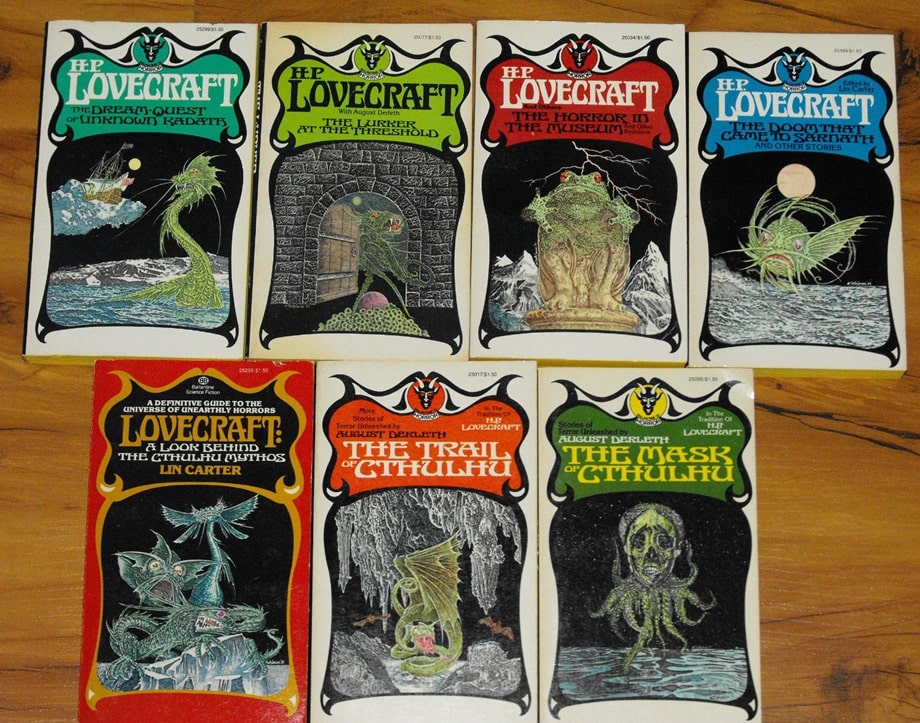
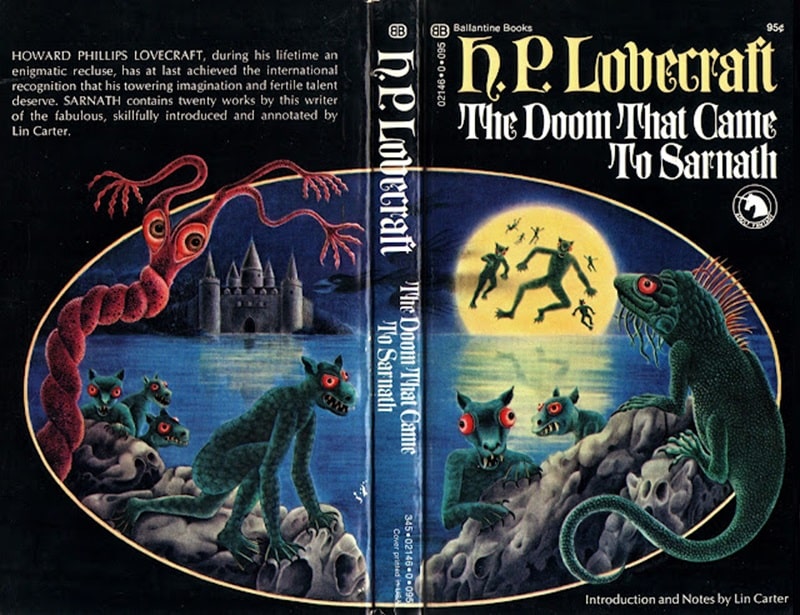
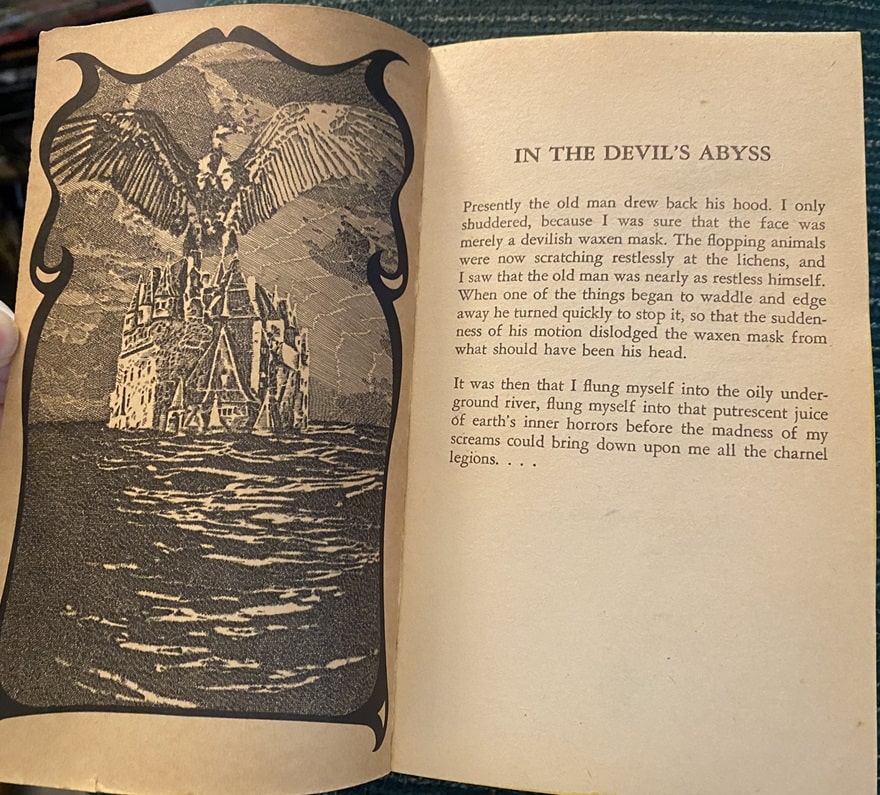
I love the Dreamlands stories! I never owned that copy of Doom That Came to Sarnath — my copy was from the rerelease with Michael Whelan covers — but I did have that matching edition of Dream Quest of Unknown Kadath, which is one of my secret top 5 Lovecraft stories. (And then I later went back and got Ballantine Adult Fantasy editions of both of them because, well, BAF.)
Joe,
I envy you that matching Dream Quest volume with the Murray Tinkelman cover — that’s a hard get, and it’s missing from my collection.
But I wouldn’t trade my BAF editions, with the enchanting Gervasio Gallardo covers. They are a delight. The Gallardo cover for Dream Quest is probably my favorite cover from the entire BAF line.
I remember Dream-Quest fondly; I should reread it.
I think a case can be made that At the Mountains of Madness, at least, is properly classified as science fiction. For all its characters are confronted with terror, a major theme of the story is wonder, and at the end, the narrator regards the alien beings not as monsters but as fellow beings that he respects. It’s perhaps unusual for Lovecraft, but I think the SFnal sensibility is definitely there.
I think that’s true of a number of his later stories — Mountains, Colour Out of Space, Whisperer in Darkness, Shadow Out of Time, etc.; particularly the bits in Mountains, Whisperer and Shadow where he gives a secret history of the entire cosmos. Those vast gulfs of space & time make him feel like nothing so much as Olaf Stapledon’s evil twin Skippy.
I certainly see that for The Shadow out of Time, which in fact I thought of mentioning. I have my doubts about The Colour out of Space, which seems to be much more purely horror, not least in that it doesn’t suggest any sort of explanation for the phenomena it describes.
I think a case can be made that it prefigures a lot of the 1950s SF horror movies — the inciting incident is a meteor strike, and they mention scientists testing the fragments, at least until they dissolve.
Bill,
Yeah — I consider At the Mountains of Madness science fiction, and so did John W. Campbell, who published it in Astounding. It’s good pulpy fun, whatever you call it.
Not to get too geeky-picky, but isn’t that a pre-Campbell Astounding?
Thomas,
You are entirely correct. Campbell wasn’t hired until October 1937, and didn’t gain full editorial control until March 1938. F. Orlin Tremaine was the editor who bought At the Mountains of Madness for Astounding.
This is from Wikipedia:
“Tremaine’s policy of printing material that he liked without staying too strictly within the bounds of the genre led him to serialize H.P. Lovecraft’s novel At the Mountains of Madness in early 1936. He followed this with Lovecraft’s “The Shadow Out of Time” in June 1936, though protests from science fiction purists occurred.”
Both The Doom that Came to Sarnath and The Dream Quest of Unknown Kadath are well worth reading if you haven’t already. The same can be said for just about anything from the pen of Lord Dunsany, especially his Pegana stories. Both men were Masters of Fantasy.
Thank you for the post, Mr. O’Neill.
You’re very welcome, John.
I haven’t read the Pegana stories, but I did recently acquire a copy of the the Dover edition of Gods, Men and Ghosts: The Best Supernatural Fiction of Lord Dunsany. It would make a fine VINTAGE TREASURES post on its own, I think.
Years ago Chaosium put out the complete Pegana stories in their Call of Cthulhu line of books. That’s the edition I have. I’m surprised that *cough* some intrepid editor-type-person has never done a piece looking at those Chaosium Lovecraft books…
Thomas,
Fair cop. Chaosium published 14 volumes in the Call of Cthulhu Fiction line between 1993-97, and I studiously collected them all. They’re expensive these days, and frankly I thought many were fairly weak anthologies, but there’s no doubt there’s a lot of terrific stuff in these books.
There’s a complete list at ISFDB, which includes the expanded editions from 2006 and later.
https://www.isfdb.org/cgi-bin/pubseries.cgi?1744
I have that same Dover collection! I picked it up at a used bookstore in my childhood hometown many years ago, I think on the strength of having heard about Lovecraft’s affinity for things Dunsanian.
It’s an excellent collection, not least because of the Sime illustrations.
Lord Dunsany… *chef kiss.*
IMHO, it’s Lovecraft’s prose style as much as his narrative choices and eldritch weirdness that defines him. To say it’s purple seems hardly sufficient, especially––and this is key––when compared to the minimal style now in vogue across nearly all genres of English writing. I’ve currently reading “Oliver Twist,” and it’s notable that Dickens, like most of the Victorian novelists, never met a sentence to which he couldn’t add clauses, and Lovecraft, a good many years later, kept right on plowing the same field. A lot of his contemporaries had already adopted a relatively spare prose-style, but never Lovecraft. For better of for worse, he stayed the course, as your excerpt from “Sarnath,” above, underscores. Try submitting prose of a similar stripe to fantasy mags, publishers, or editors in this day and age and you will garner a great massing heap of rejections, just as quick as you can say “Jack Robinson was devoured by Nyarlathotep.”
Mark,
Very true. There were a small number of folks who submitted stories to Black Gate in conscious (or perhaps unconscious) imitation of Lovecraft; I never made it through more than a page or two before passing along a rejection slip. Modern readers have little appetite for it, and to be honest, I don’t much either.
I enjoy Lovecraft’s fiction very much, but that’s doesn’t mean I’m anxious for his style to make a comeback. Lovecraft was an original.
The thing I find most surprising these days when I reread Lovecraft is how strong his sense of PLACE was (almost like Tolkien in that regard, if no other) — read the opening bits of Colour Out of Space or Dunwich Horror, etc., and you’re really up in those desolate New England wooded hills and valleys.
Agreed. I used to teach “The Strange Music of Erich Zann” (might have the title slightly wrong) and his place-setting was top-notch, which was doubly odd, since it’s set in Paris. Or a “Lovecraft” Paris. “It’s just a jump to the left…”
i confess I am not a Lovecraftian on the whole, but I adore Lord Dunsany’s work. And I think the best Lovecraft — though still not on a par with Dunsany — is his work in Dunsany’s vein, such as “The Doom that Came to Sarnath” and “The Dream Quest of Unknown Kadath”. I admit that’s a non-standard view, and I don’t begrudge Lovecraft’s fans their own preferences. (I admit on first seeing the title “The Doom that Came to Sarnath” I thought it would be by Dunsany.)
So I strongly recommend that Lovecraft fans read Dunsany’s short fiction (stories like “The Sword of Welleran”, “The Fortress Unvanquishable, Save for Sacnoth”, “Idle Days on the Yann”, and “How Nuth Would Have Practised his Art Upon the Gnoles”.
I think Dunsany is sometimes neglected as vital influence on later fantasists — and SF writers — surely Leigh Brackett and even Jack Vance were heavily influenced by him. I certainly acknowledge the seminal influences of Tolkien, Howard, and Lovecraft — but Dunsany was in there too.
Also, those who like “The Dream Quest of Unknown Kadath” should definitely read Kij Johnson’s glorious novella “The Dream Quest of Vellitt Boe”.
Agree completely, and don’t forget Dunsany’s novels – I would rate The King of Elfland’s Daughter as one of the greatest of all fantasies.
YES! It was so difficult to find for years, but very worth the reading.
These editions were my introduction to Lovecraft. I was in high school and haunting the science fiction/fantasy section of the independent mass market paperback bookstore (such places once existed) just across the state line in Toledo which is where I first encountered them. The Tinkelman collages-part Xeroxed stock photos, part outlandlish Radiograph pen illustrations-had a bold, graphic quality that seemed quite striking at the time. It was a stlye that had the curious effect of seeming cheap, DIY-edgy and avant-garde at the same time and was briefly used everywhere from advertising to album covers to perhaps most memorably the films of Ralph Bakshi (particularly “Wizards” and “The Lord of the Rings”).
All I knew about Lovecraft at the time was a faint idea of the Cthulhu mythos and their influence on weird fiction so the prose poem fantasies threw me for something of a loop. I found them fascinating but ultimately unsatisfying if only because I was expecting something more in a horror vein. I moved onto the Cthulu stories with the assumption the early work was of minor value and republished solely to capitalize on the author’s surging popularity.
It wasn’t until I read some of S.T. Joshi’s commentaries on Lovecraft that I first heard of Dunsany and was intrigued enough to pick up the Penguin volume that was published a few years back. Like so many others I was thrilled, astonished and thoroughly hooked. I’ve never considered going back to Lovecraft’s Dunsany inspired efforts but this article and the excerpts you’ve provided have given me cause to reconsider. I got rid of the Ballantine editions some years ago but they aren’t too expensive on Ebay and I’m always looking for warm-up reading for my yearly autumn weird and horror binge so I’ll be picking these us.
Thanks.